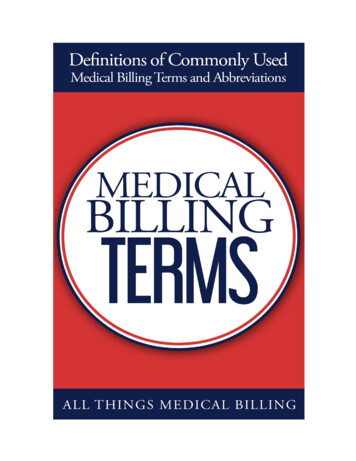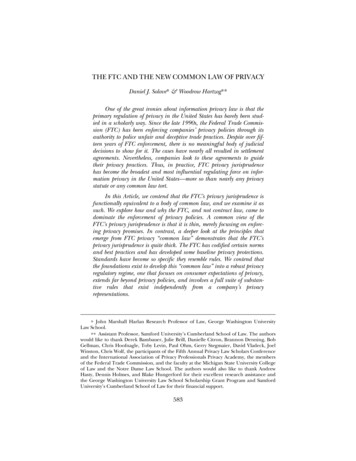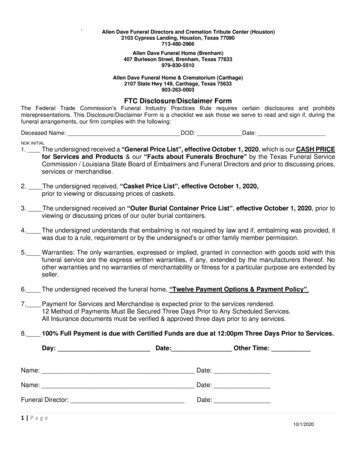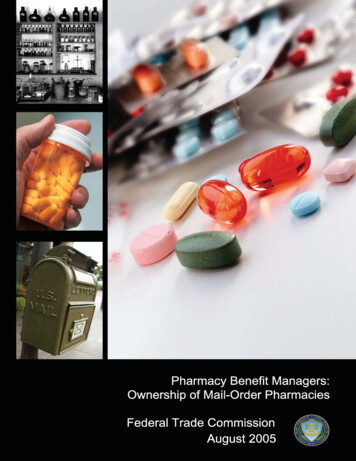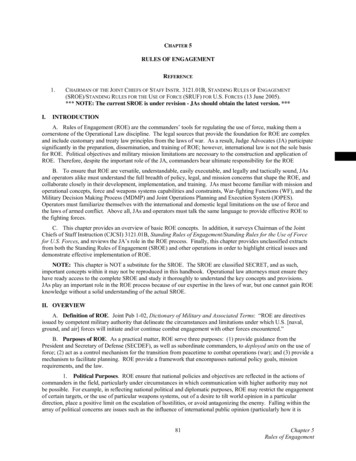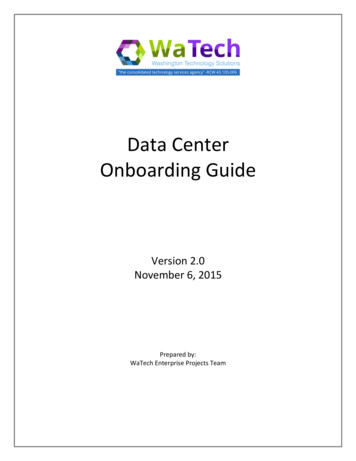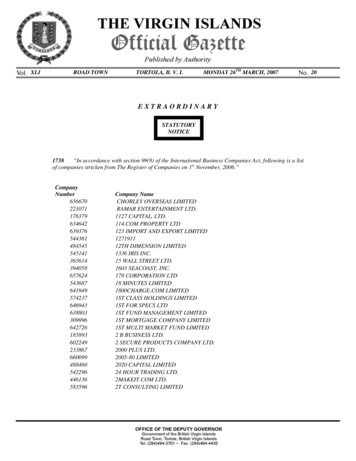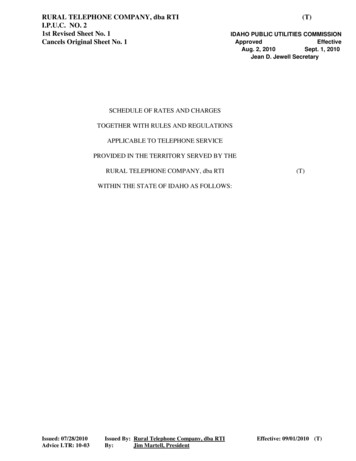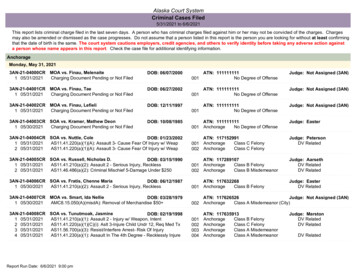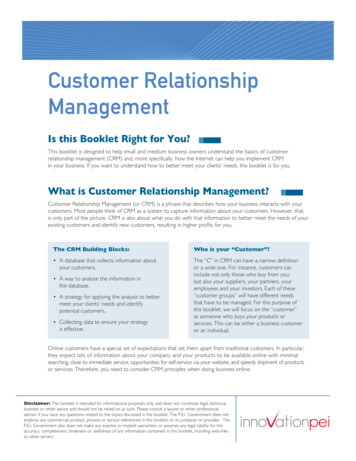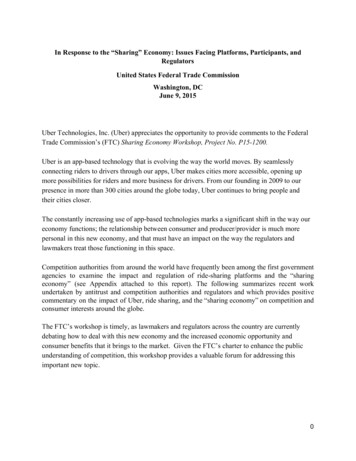
Transcription
In Response to the “Sharing” Economy: Issues Facing Platforms, Participants, andRegulatorsUnited States Federal Trade CommissionWashington, DCJune 9, 2015Uber Technologies, Inc. (Uber) appreciates the opportunity to provide comments to the FederalTrade Commission’s (FTC) Sharing Economy Workshop, Project No. P15 1200.Uber is an app based technology that is evolving the way the world moves. By seamlesslyconnecting riders to drivers through our apps, Uber makes cities more accessible, opening upmore possibilities for riders and more business for drivers. From our founding in 2009 to ourpresence in more than 300 cities around the globe today, Uber continues to bring people andtheir cities closer.The constantly increasing use of app based technologies marks a significant shift in the way oureconomy functions; the relationship between consumer and producer/provider is much morepersonal in this new economy, and that must have an impact on the way the regulators andlawmakers treat those functioning in this space.Competition authorities from around the world have frequently been among the first governmentagencies to examine the impact and regulation of ride sharing platforms and the “sharingeconomy” (see Appendix attached to this report). The following summarizes recent workundertaken by antitrust and competition authorities and regulators and which provides positivecommentary on the impact of Uber, ride sharing, and the “sharing economy” on competition andconsumer interests around the globe.The FTC’s workshop is timely, as lawmakers and regulators across the country are currentlydebating how to deal with this new economy and the increased economic opportunity andconsumer benefits that it brings to the market. Given the FTC’s charter to enhance the publicunderstanding of competition, this workshop provides a valuable forum for addressing thisimportant new topic.0
THE BENEFITS OF RIDESHARING AND UBERThe establishment of digital platforms that tap into a broader supply of vehicles and drivers thanwas previously possible largely due to artificial regulatory barriers, and the resultant ability toprovide a reliable, cost effective service at scale brings with it a whole host of positive effects forriders, drivers, and the cities where these platforms operate.Consumer BenefitsThe Uber platform offers riders a new option for point to point transportation that supplementsthe menu of options they previously had access to. In a basic sense, giving riders one morechoice can only make them better off. The advantages to riders over traditional transportationoptions are many, and they include: Access to transportation at a significantly lower cost Access to transportation in neighborhoods that were previously underserved orhad no service Access to reliable transportation in an unprecedentedly short amount of time Access to transportation in conditions of relatively high demand when otherfor hire options are typically unavailable (e.g., rush hour, bad weather, holidaysor special events like concerts, sporting events, New Years Eve, Saint Patrick’sDay) Access to transportation from comfortable and safe requesting locations (e.g.,indoors) rather than street hailing Consumer protections such as transparency of fare rate, itemized receipt, andrecorded trip routes, which protect consumers against inflated fares Ability to request transportation for friends and family in other locations Safe, high quality service from drivers with ratings provided by the prior riders Variety of choices depending on which services are provided by local for hiredrivers in a given city (e.g., uberX, UberBLACK, uberXL, uberPOOL, etc) Guarantee of simple electronic payment by credit card Reliable estimates for fares on upcoming trips Ease of adjudicating disputes between riders and drivers via Uber’s store ofadministrative data, and highly responsive customer service system Ease of requesting a for hire driver in any city in which the service operatesThese advantages are not hypothetical. In the few cities in which reliable information ontaxicab service levels by neighborhood are available, Uber provides reliable rides within1
minutes where taxi (when you can order one) provides unreliable rides with wait timesoften in excess of 30 minutes (see our Boston blog post , for example). The average waittime in the United States across all Uber product lines is 4 minutes.By freeing drivers from the expensive and fare increasing burden of medallion and taxilease fees, Uber has also decreased the cost to riders of many forms of vehicular travel.In many cities, a ride on uberX costs less than half of the taxi equivalent fare, anduberPOOL, which matches riders whose trips overlap, promises even greater costsavings.Reliability and affordability also translates into fewer incidents of impaired driving, as riders areable to make smarter decisions when they most need to. A 10% decline in DUI arrests in Seattleafter Uber entered the market, and a 6.5% decline in alcohol related crashes involving under 30year olds in California following the launch of uberX are but two examples of that impact.Provider BenefitsThe Uber platform offers for hire drivers and individuals a new option for providingservices and earning income (in this case point to point transportation) that supplementsthe menu of options they previously had access to. In a fundamental sense, givingdrivers one more choice can only make them better off. The advantages to drivers overtraditional market options are many, and they include but are not limited to: No barriers to entry or exit the market for for hire drivers has increasedsubstantially as a result of the removal of the traditional medallion barrier. Maximum flexibility in choosing hours, effort, and style of work, includingability to “mix and match” services across multiple platforms such as Uber andLyft, which is especially important to those with irregular schedules, such asworking parents, students, and caregivers Indicators of demand like heat maps allow drivers to more efficiently andeconomically provide rides in more areas Dense network of demand and intelligent allocation of available driver partnersto nearest riders create efficiency and a high utilization rate drivers spend moreof their time with paying customers rather than waiting in long lines forcustomers No daily or weekly lease or medallion payments that distort driving incentives Ability to take advantage of existing capital (such as the cars that drivers alreadyown) or to invest in new capital ( i.e. , new vehicles) Hourly earnings commensurate with local conditions, often in excess of earningsavailable to existing for hire drivers in the taxi industry2
No payment risk, as all transactions are electronic and guaranteed by theplatform No need to handle large amounts of cash, and the resultant reduction in the riskof robberies Rating system keeps customers on best behavior and allows riders to rewarddrivers for providing high quality service Ease of adjudicating disputes between riders and drivers via Uber’s store ofadministrative data and customer service systemIn addition, the technology behind Uber’s platform improves and expands the driver’sopportunity.For example, having a large scale and flexible service allows people to find a ride even if theylive farther out from downtown areas, in neighborhoods with poor, or nonexistent, taxi service.In New York City, 35% of all Uber pick ups happen outside of Manhattan , compared to just 6%by traditional taxis. One African American commentator noted that “the quality of our livesimproved tremendously once we found a workaround to dealing with rude and racist cabdrivers,” while another appreciated that Uber’s “guiding principle [is] based on the color of themoney in your pocket and not the color of your skin.” In Boston, almost every trip on the Uberplatform in every neighborhood starts in less than 20 minutes. For taxis, over a third of trips inpoorer neighborhoods don’t start in 20 minutes.Similarly, more than 30,000 New York City residents sign up as new riders on Uber each week,and an increasing number of these new riders are located outside of lower Manhattan, in theouter boroughs, which have been traditionally underserved by taxi. These riders sign up for Uberbecause they need a safe, reliable, convenient way to get from A to B, at all times of day ornight, wherever they are, with no discrimination based on location. In fact, 27% of Uber rides arein to, from, or within the outer boroughs (excluding airports) compared to 6% of traditional taxipickups.Data reveal that a significant number of rideshare trips start or end at mass transit terminals.Uber encourages the use of mass transit by providing a “last mile” linkage to already built transitsystems. By connecting communities with few or no mass transit options to the transit network(e.g. the outer boroughs) – that crucial last mile – ridesharing helps reduce commute times,increase productivity, and bring more job opportunities within reach of more people.Rideshare platforms also provide people a new option for earning. These platforms supportflexible and control over work schedules in a way that traditional models simply cannot. Drivers3
choose when and for how long to work. When surveyed, this is an aspect of the Uber platformthat over ⅔ of drivers found to be compelling.In a recent study of Uber driver partners by Dr. Jonathan Hall and Dr Alan Krueger, theeconomists found:The most common reasons (combining major and minor reasons) [for joining theplatform] were: “to earn more income to better support myself or my family” (91percent); “to be my own boss and set my own schedule” (87 percent); “to have moreflexibility in my schedule and balance my work with my life and family” (85 percent);“to help maintain a steady income because other sources of income areunstable/unpredictable” (74 percent).Many individuals, both by choice and by circumstances, value the opportunity to work“on demand” when the opportunity arises so that they can better meet family and otherwork obligations. Uber and other sharing platforms cater to this demand for flexibleincome opportunities. In the past, medallion and taxi dispatch owners have incentivizedlong shifts (often 10 12 hours) via large up front costs to drivers on a daily or weeklybasis.The safety of Uber’s platform also expands women’s economic opportunities in particular, byensuring a safer and more respectful work environment, allowing them to pursue entrepreneurialwork opportunities in what has historically been a male dominated industry. A recent surveyrevealed that approximately 14% of Uber drivers are women; that compares to less than 1% ofNew York yellow taxi drivers.Ridesharing also benefits small businesses throughout a city. Because riders know they can relyon Uber for a ride back from wherever they’re going, the platform encourages people to travelmore widely throughout their city, visiting a more diverse range of neighborhoods than theyotherwise would and patronizing those small businesses that cannot afford prime downtown realestate. In Chicago, for example, 1 in 3 trips on the Uber platform last year began or ended at alocal small business.Finally, competition from rideshare platforms has also encouraged service improvement byexisting providers. Taxi fleets across the country are now using “e hail” apps to dispatch theirtaxis in a more intelligent manner. A report released by the Technology Policy Institute ,concluded that faced with competition from Uber, taxis are improving their service. ExaminingNew York City taxi complaint data, the researchers found that the number of complaints per taxitrip in New York has declined alongside the growth of Uber in that market. And looking at4
comparable data from Chicago, they found that certain complaints — driver willingness to turnon air conditioning, acceptance of credit cards, driver rudeness, and talking on cell phones — allseem to have decreased along with Uber’s entry and competition in the market.Added Safety and Transparency: Uber’s Rating SystemAt the end of every trip on the Uber platform, the rider and driver are each required to rate theother on a scale from one to five stars. Riders and drivers also see each other’s overall averagerating before choosing to begin a trip. This rating system does three critical things: it (1)incentivizes high quality service, (2) establishes accountability, and (3) promotes courteousconduct, and helps to mitigate the discrimination that is all too common in traditional for hiretransportation.First, Uber’s rating system incentivizes high quality service. Riders are attracted to the platformbecause they can expect a polite interaction and a clean, well maintained car from a highlyrated driver. Indeed, riders know that drivers who choose to work on a platform that recognizesand rewards performance are exactly those drivers who are confident of, and committed to,doing a good job. Similarly, the rating system appeals to drivers because it offers them aneffective way to distinguish themselves and the high quality service they provide and thusattract more customers, including and especially those who would otherwise avoid for hiretransportation outright due to quality concerns.Second, Uber’s rating system also establishes accountability and promotes courteous conduct.Riders are drawn to the platform because they can expect highly rated drivers to provide politeand helpful service. This is particularly important when riders feel more vulnerable –after anevening of drinking, for example. The two way rating system protects drivers as well. They canfeel comfortable picking up a highly rate rated rider, even in an out of the way area or at a timeof night that might otherwise discourage them, and so increase their overall business. Bypromoting a safe and respectful work environment for drivers, the rating system also helps toopen
Lyft, which is especially important to those with irregular schedules, such as working parents, students, and caregivers Indicators of demand like heat maps allow drivers to more efficiently and economically provide rides in more areas .
